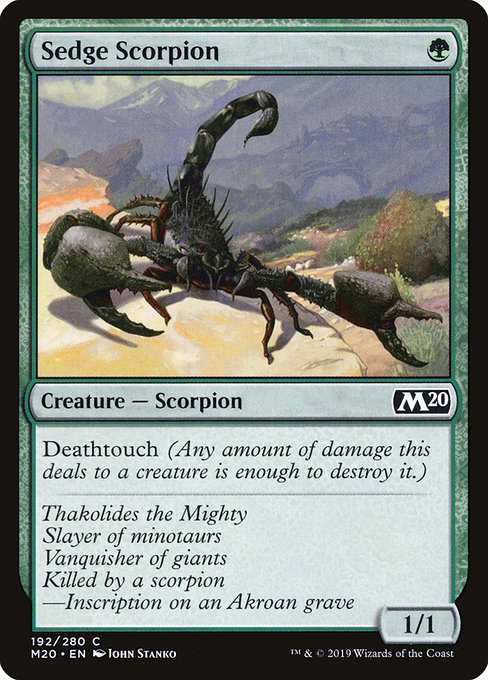
Image courtesy of Scryfall.com
Constraints as Creative Fuel: A Green Lesson from Sedge Scorpion
In the vast, swirling world of MTG deckbuilding, constraints aren’t speed bumps; they’re design theorems waiting to be solved. The green side of the color pie often leans into efficiency, breadth, and tempo, and a tiny creature like Sedge Scorpion is a perfect microcosm of how a single constraint can spark clever, dish-sharp strategies 🧙♂️. With a mana cost of just a single green, this 1/1 creature embodies the idea that value isn’t always measured in raw stats or flashy lore; it’s about how you squeeze impact from limited resources. The moment you realize you’re building around constraints—whether budget, curve, or a targeted synergy—you start to notice MTG’s design magic at every turn 🔥.
Released as part of Core Set 2020, Sedge Scorpion is a common green creature that carries the classic MTG sword of deathtouch: a single point of damage is enough to destroy any creature it threatens. That tiny, venemous package invites a deckbuilder to lean into the card’s true power: value through selective combat. You’re not chasing power on the second or third turn; you’re creating reliable pressure while forcing your opponent to pivot around carefully calculated trades ⚔️. The deathtouch keyword makes high-stakes decisions feel tactile, turning a small investment into meaningful battlefield shifts, especially when you’re constrained by a lean mana curve and a tight threat density 🎯.
Constraint-driven deckbuilding often yields two kinds of clarity: what to include and what to exclude. Sedge Scorpion teaches patience—do I jam another 1-drop that’s technically stronger, or do I diversify with a curve that preserves reach through the midgame? The green philosophy tends to favor efficient bodies, card advantage via incremental value, and a willingness to engage in tight, tactical combat. The result is a deck that’s more resilient to disruption when every card earns its keep. And in formats where tempo matters, a single-death-touch creature can anchor your early game while you sculpt the rest of the plan around your constraints 💎.
Thakolides the Mighty Slayer of minotaurs Vanquisher of giants Killed by a scorpion —Inscription on an Akroan grave
Sharp, small, and savage: Sedge Scorpion in practice
Let’s unpack how this modest green drop can illuminate a constraint-heavy approach to deckbuilding. First, its mana cost is deliberately minimal. In a world of ramp and beefy threats, a lone green mana and a 1/1 body might seem underwhelming—until you factor in deathtouch. The rules create an equalizer: even though your Scorpion is small, it can trade with a big creature if you can assign damage. That dynamic invites you to build around selective trades, rather than mass removal or brute force. Your constraints push you toward careful combat planning, which is a core skill in any MTG format 🔥.
Second, Sedge Scorpion helps you embrace a lean curve. If you’re crafting a budget-conscious or tempo-focused green deck, you’ll likely pair it with a handful of similarly costed creatures, efficient removal, and perhaps a splash or two for reach. The constraint isn’t “how can I cram more power?”; it’s “how can I maximize impact with minimal investment?” Deathtouch becomes a tactical tool, allowing you to threaten trades that would otherwise be unfavorable and forcing opponents to overcommit or rethink attacks 🎲.
Finally, the card’s green identity—the theme of resilience through efficiency—illustrates how constraints can shape color strategy itself. Green often shines brightest when it can deploy a flurry of small bodies, accelerate into stronger threats, and win through a steady tempo rather than a single haymaker. Sedge Scorpion embodies that ethos: a cost-conscious, deathtouch-enabled line of play that rewards players who savor the long-game and value every mana as if it were gold ⚡.
As you practice constraint-based thinking, you’ll also notice how the card’s art and flavor feed the experience. John Stanko’s depiction, with the scorpion’s gleaming form and sharp silhouette, invites you to imagine a battlefield where a single sting can decide outcomes. The flavor text, though compact, hints at a world where cunning and restraint trump brute force—a reminder that great deckbuilding often begins with understanding the limits you’re willing to impose and how to push them toward victory 🎨.
Beyond the table, this mindset translates to disciplined construction: curate a toolbox of efficient, synergistic pieces, reject filler cards that fail to advance your plan, and embrace trades and tempo as your primary levers. Sedge Scorpion doesn’t just fit a green deck; it exemplifies constraint as a design principle. When you’ve got a clear constraint—budget, curve, or a specific synergy—you start spotting opportunities you wouldn’t notice in a flood of options. That’s the magic of MTG: constraints unlock creativity and turn a simple 1/1 into a catalyst for smarter, sharper deckbuilding 🧙♂️💎.
As you experiment with constrained color strategies, you might also enjoy keeping your everyday gear as pristine as your playbook. Speaking of keeping things tidy, consider this slim, durable accessory that protects your phone without weighing you down—perfect for travel between games or store events. Clear Silicone Phone Case — Slim, Durable, and Flexible 🧼📱
Clear Silicone Phone Case — Slim, Durable, and FlexibleMore from our network
- https://crypto-acolytes.xyz/blog/post/understanding-the-lightning-network-fast-bitcoin-transactions-explained/
- https://transparent-paper.shop/blog/post/managing-burnout-as-a-solopreneur-practical-recovery-steps/
- https://blog.digital-vault.xyz/blog/post/profit-loss-tempo-advantage-for-dimir-control/
- https://crypto-acolytes.xyz/blog/post/understanding-the-meme-coin-cycle-why-it-repeats/
- https://blog.digital-vault.xyz/blog/post/clustering-mtg-cards-by-mechanics-valleymaker-edition/